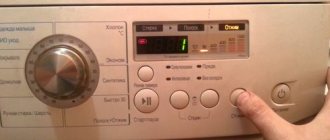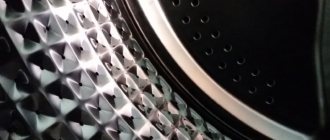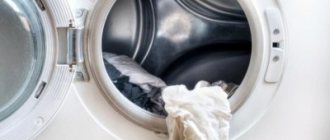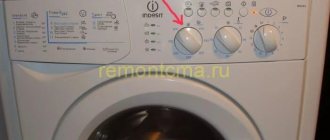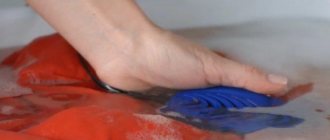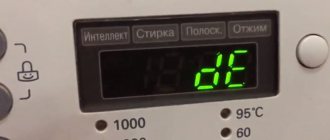- home
- Articles
- Washing machine stains clothes
Many owners of modern household appliances are familiar with the situation when, after washing, dirty clothes come out of the machine drum.
And it’s not that the powder didn’t do the job, or the contamination was too complex. We are talking about equipment malfunction. If the washing machine stains your laundry with brown spots, black stains, and gray dots, then you need to figure out the reason for such unpleasant effects. The spots may be rusty, oily, yellow, or bleached. There may be blots or stains. If equipment leaves stains on clothes, it is worth checking the objective reasons, and then calling a specialist for repairs. In this case, you should not continue to use the machine, as you may simply ruin your clothes.
Why does the washing machine stain laundry: looking for reasons without breakdowns
Stains on laundry do not always mean failure of household appliances. Before calling a washing machine repairman, check for other reasons that are not related to the problem. The appearance of dark spots after washing is sometimes due to the fact that you set the mode incorrectly or used the wrong household chemicals for your equipment.
The main reasons are the following:
- the laundry has faded - this happens if you choose to wash at a high water temperature, and there are things of different colors in the tank;
- there is rust in the water - after plumbing work, dirty rusty water may be poured into the tank of the machine through the water pipes;
- metal parts are rusty - it is worth inspecting the tank for traces of rust, usually this is a sign of long-term downtime of the equipment;
- the wrong powder was selected - you may have used dyeing or bleaching powders on items that cannot be washed with such products;
- too much powder or linen - in the first case there will be a bleaching effect, in the second - things will exchange colors with each other;
- dirty machine body - often in front-loading machines, owners forget to wipe the seal, and things get smeared when they are removed from the tank.
Usually, studying these possible reasons answers the question of why stains appear on things after using a washing machine. If none of the options clears up the situation, and the equipment continues to stain your clothes, you will have to contact a specialist. This is a common sign of a breakdown, which may indicate that the equipment will soon fail. Therefore, you should contact specialists as early as possible.
SMA breakdowns - causes of spots
The causes of contamination associated with the condition of the washing machine are indicated by dark marks. If you do not regularly care for the device, problems can appear from different sides. Let's consider cases of laundry contamination caused by technical problems and poor care of SMA.
The cuff is dirty
It is recommended to wipe the cuff regularly. If this is not done, dirt will accumulate in the fold of the cuff, and then mold will form - a gray coating will form. The result is gray marks. To fix the problem, clean the cuff with a brush. Do this carefully, but carefully, so as not to damage the cuff.
Oil seal leaked
If the washer leaks from the bearing side, the drum seal has probably failed. It should be replaced with a new one. As soon as the oil seal leaks, the device is stopped immediately, otherwise water will get on the bearings and they will rust. The oil seal must be replaced as soon as possible; if you delay, the bearings will rust and begin to creak and make other unpleasant sounds. Rust causes laundry to become dirty.
Replacing the oil seal requires replacing the bearings - this procedure is best left to professionals. If the tank is collapsible and the owner of the machine wants to change the damaged parts himself, you need to buy bearings - 2 pieces, and an oil seal. Select the right bearing - take out the old ones and look at their number, and then buy exactly the same or suitable analogues.
Due to worn seals, oil or fuel oil appears on washed clothes, since when these parts wear out, they release oil into the tank, which then ends up on the fabric.
Seal replacement procedure:
- Removing the top panel.
- Removing the bottom cover.
- Removing the front panel.
- Removing the rubber cuff.
- Disassembling the tank of the machine into two parts.
- Replacement of bearings and seals.
The tank is very fragile, so the bearings should be knocked out very carefully. New bearings are driven into places that have been previously polished to a shine. The new oil seal is lubricated with waterproof oil and inserted into place. Read more with photos and videos here.
The pump, tank or pipe is dirty
A clogged drain system is another reason things get dirty. The pump, tank and pipes can become clogged in two ways:
- Mechanical. By chance, foreign objects appear in the drain system, blocking its operation. These can be any small objects - coins, buttons, etc.
- Natural. These blockages form gradually - due to the ingress of wool, hair, lint, etc.
To clean the system, you need to:
- Clear the blockage in the garbage filter drain.
- If there is no debris in the drain, the SMA is disconnected from the power supply, water supply and drainage system - for ease of operation. Tilt the device to the left to get to the pump and pipes, which should also be checked for blockages.
- If no blockage is found there, remove the pump and then the motor to open the way to the main pipe leading to the waste filter.
- If there is no blockage in the pipe, you will have to contact a specialist to find out the origins of the problem.
How to clear the blockage yourself:
- Remove dirt or objects stuck in the system directly with your hand or something thin, such as a screwdriver. There can be many clogs, so removing one of them does not guarantee a solution to the problem.
- Along with mechanical cleaning, it is useful to chemically clean the system using a special cleaning agent. A drug, for example Dr. Beckmann, pour into the cuvette and turn on the machine in 90 degree mode. The product can be poured directly into the drum - if there is dirt on its walls.
Mold in the internal parts of the SMA
Lack of SMA care or improper care leads to the formation of mold. It can appear in various parts of the washing machine - in the detergent tray, in the cuff, in the drum, tank, pipes. Mold also causes stains.
Why does mold appear:
- closing the wet compartment for detergent;
- closing the drum door immediately after removing items.
Ventilating and drying the machine helps prevent the formation of mold - so, according to the user instructions, do not close the hatch door after using the machine for some time, but it is better to keep it ajar all the time.
You can guess the presence of mold by the smell - just sniff the “inside” of the drum. To find out where there is mold, proceed as follows:
- Unfold the cuff and inspect all the cracks.
- Inspect the inner walls of the drum.
- Look into the detergent drawer.
- Remove the cuvette and inspect it.
If you find a dark fluffy coating in at least one of the examined places, it will become clear where the gray dirt on the washed items comes from.
If there is mold in the washer, things will smell unpleasant even after using the best conditioner.
Procedure for removing mold:
- soda is poured into the cuvette - about 300 g;
- select the maximum water temperature;
- start the device at idle speed, turning on double rinsing.
The process is repeated until the mold is completely eliminated.
Rust
If a corrosive object gets stuck inside the washer, it can cause rust stains. For example, a nail, paper clip, or other small metal item that has fallen out of your pockets can rust. Once they get behind the cuff, they begin to rust there, and the owner of the SMA does not even suspect the presence of a small “saboteur” until he reveals himself. The user’s task is to quickly detect and remove a foreign object from a secluded place.
To prevent rust from forming inside the washer, water softeners are used.
To remove traces of rust, pour salt on top and then lemon juice. After a day, wash the soiled item. If this does not help, you will have to purchase a special stain remover.
If you choose and dose powders correctly and follow the operating rules of the washing machine, then the washing result will be what we expect. Any violation or lack of care for SMA can result in damage to things with further waste of time and effort to correct the consequences of negligence.
Main possible breakdowns
If you were unable to overcome the problem with your own hands, you will have to contact a workshop and order repair of the washing machine. Owners of household appliances often contact the service center and complain that the machine stains things with black spots. The technician can already find the problem with a superficial diagnosis. Initially, the condition of the cuff is checked, in the fold of which dirt and mold can accumulate. You should also wash the powder tray; mold may form here. The inlet filter is replaced with a new one to prevent dirt from entering through it.
Next, the specialist will diagnose the machine for the following faults:
- a metal object got into the tank and rusted - in this case, the equipment stains things with brown spots when washing;
- the oil seal separating the shaft bearing and the drum leaks - grease gets into the wash and stains things;
- due to poor water quality, the supply tube is dirty, it can be washed or replaced;
- the pump is dirty (some models have a fill pump or valve, as well as a circulation pump).
Most of these problems are easy to fix. To do this, you need to wash the filters and pumps, eliminate poor seals of the seals, and check the condition of the tubes. Such diagnostics often take about 20 minutes. During this time, the specialist will indicate the reasons why your washing machine smears things and leaves stains on clothes when washing.
The cuff is dirty or there are problems with the seal
Mold in the middle of the washing machine is just a small thing. The reason why a housewife gets her things dirty may also lie in other problems. So, if the washing machine has been improperly cared for (or not cared for at all) throughout the year, a thick layer of gray dirt will accumulate on the cuff and under it. After washing, it will appear as small gray spots on things.
Important ! It often happens that so much dirty plaque has formed that it simply begins to fall out of the cuff in clumps right during washing. Then all this “happiness” will settle on your things. The picture is not the most pleasant.
What to do with such a problem? You just need to take a medium-hard brush (a toothbrush will do), a rag, and start cleaning the cuff of all this “good.” Plaque must be removed wherever possible - from every crack. The main thing is not to overdo it and not harm the cuff.
If after washing you take out items with oil or fuel oil stains, then the problem in 90% of cases lies in the seal. The thing is that when the seals wear out, they begin to throw oil into the water tank, which then ends up on clothes.
In such a situation, you need to act extremely quickly, since when they “die,” the seals will not only stain the fabric, but will also constantly take on a large flow of water. This will lead to corrosion and the bearings will very quickly become unusable.
It may be that you are too late and the bearings have already broken. They will “give” themselves away by creaking and grinding during washing. As in the first and second situations, urgent replacement of oil seals and bearings is necessary.
This procedure is quite complicated and it is best to entrust it to professional craftsmen. Of course, you can try it yourself, but then you will have to do the following:
- Completely disassemble the machine;
- Make a cut using a grinder and remove the tank;
- Carefully remove the failed bearings and install new ones.
How much does it cost to fix the problem?
Fixing the problem can cost several hundred rubles. If we are talking about a dirty pump that can be washed, you will only have to pay for a technician’s visit and diagnostics. If it is necessary to replace expensive parts, most of the total cost of repairs will be the cost of components. But stains on white clothes after washing will cost you more than timely restoration of the equipment. Sometimes you just have to throw things away if they are stained with lubricants or other greasy contaminants.
The final cost of repairs can only be determined by a specialist after studying the problem. Don't wait, it's better to call a specialist and pay for diagnostic work than to risk your clothes. Moreover, the problem may turn out to be minor, and you will not have to endure the inconvenience of washing.
Brown spots appear on clothes after washing
The washing machine is designed to clean clothes from various contaminants, but not vice versa, and the formation of new contaminants after washing is unacceptable. If this does happen, you can determine its origin by the color of the stain and, using the advice of specialists, fix the problem.
Thus, red, brown and light brown, orange stains remain on the surface of the material in two cases:
- after washing in rusty water;
- when a metal object remains in the machine body for a long time.
Water quality
The quality of washing directly depends on the purity of the water. If rusty water flows from the tap, then turning on the machine is out of the question, since rust will not only stain all the laundry, but will also contaminate the internal parts of the machine. Most often, this problem occurs in houses with an old pipeline or after turning off the water for repair work.
In some regions, tap water has a high iron content. Light-colored clothes washed in such conditions become covered with slightly noticeable orange stains. In this case, you cannot do without installing a special filter.
Metal object in the tank
Another common reason for the formation of brown stains is the entry of an iron object into the body of the machine. Coins, nails, hairpins and pins that fall out of pockets and remain at the bottom of the tank become rusty over time and stain clothes.
To eliminate the cause of contamination, you need to unscrew the filter and remove unnecessary objects. Usually this simple operation is handled independently, without the help of specialists.
Experienced technician and fair prices for repairs
The service center offers restoration of household appliances. We work with washing machines from all manufacturers. Diagnostics and restoration are carried out at the customer’s home; there is no need to waste time and money on transportation. The technician will quickly detect a breakdown, indicate the cost of restoration, or perform a flush immediately after diagnosis. The prices will please the customer. Extensive experience in working with household appliances allows us to provide a guarantee on the work performed. This means that after the master leaves, you will confidently use the equipment and stop worrying about your things.
White spots on black clothes after washing
The reasons for the appearance of bleached spots on dark or colored clothing may be:
- incorrectly selected or expired powder;
- incorrect dosage of detergent;
- weak water pressure;
- drum overload.
Washing powder
For washing black items, it is recommended to use a powder that does not contain bleach granules. If white spots of varying sizes appear on a black T-shirt after washing, you need to check the composition of the detergent. If chlorine or other bleach is present, it is recommended to replace it with a suitable powder.
Washing with a powder that has long expired, or using twice or more detergent will also lead to the formation of white spots on dark or colored material.
We recommend: The best ways to freshen clothes and remove the smell of sweat under your arms
Weak water pressure
At the beginning of the wash, the powder from the dispenser, along with the flow of water, enters the machine drum. If the pressure in the water supply network is low, water barely flows from the tap, then the detergent will be washed out of the dispenser for a very long time and will only reach its destination at the “rinsing” stage. Traces of powder in the form of white spots will be clearly visible on dark and colored clothing.
Increasing the pressure in a centralized water supply system is a difficult task. It is much easier to give up powder laundry detergent and give preference to gels or capsules.
Drum overload
Overloading laundry can cause white stains on a black tank top or shirt. In this case, the powder particles are trapped between the fibers of the fabric and cannot completely dissolve.
It is better to load the machine drum 2/3 of the volume specified in the instructions.
Can low-quality washing powder cause dirt and bad odors?
Some low-quality powders may not dissolve well in water and lead to deposits inside the washing machine. Some chemical impurities in laundry detergent can also cause problems.
Tip number 6: wash with high-quality washing powders.
Washing powders CHISTOWN and BELIVE dissolve well even in cold water. These powders contain soda and citric acid, which protect washing machines from the inside from dirt and scale.
Causes of the washing machine and how to eliminate them
Instead of things becoming clean, they become dirty. The presence of dark, gray and even black or brown spots indicates a lack of care for the device or ignoring the procedure altogether. This results:
Cleaning the cuff
As a result of use, the rubber seal regularly comes into contact with dirty water and accumulates in the fold. If left uncared for, dirt will accumulate. Constant humidity and stagnant water cause the development of fungal microorganisms, which leads to the formation of mold.
Washing machine cuff
The cuff must be wiped regularly and the drum must be ventilated. Solution to the problem:
Mold in the tray
The container for powder and conditioner is also constantly in contact with moisture. If you don't take care of it, fungus develops there. The tank must be washed once a month, then wiped with a dry cloth and dried.
There are also such trays
Filter clogged
During operation of the washing machine, debris and dirt accumulate in it, and the development of mold is also possible. If your washing machine has a simple drain pump, a clogged filter will smell bad.
But for structures where the pump is of a recirculation type, clogging of the concentrator is fraught with new stains on things. Regular cleaning will eliminate such troubles.
Drain pump filter concentrator
Preventing scale formation
Of course, it will not be possible to avoid the appearance of scale. No matter how soft the water is in the region where you live, it will still appear (just a little slower). So you can only delay its formation by using special filters and water softeners.
IMPORTANT! Do not forget about regular general cleaning of the washing machine and all its elements.
Dirty cuff, filter or tray
The rubber sealing cuff can be effectively cleaned from mold using copper sulfate. To do this, dissolve the substance in water in a proportion of 30 grams per liter of water, and apply the resulting solution to and under the elastic band. After a day, the solution should be washed off and wiped dry with a clean cloth. To completely wash out the substance, it is recommended to run the car in the “Fast 30” mode.
If a large amount of debris is found under the rubber seal or gray or black spots of mold appear, then to clean it you will have to completely remove the cuff and then wash it in a basin or pan. If damage is found on the surface of the rubber band, it must be replaced.
First of all, dirt and debris accumulate in the drain system, or more precisely in the garbage filter and the pipes adjacent to it. They are installed for this purpose, but their performance depends on systematic care and cleaning.
The filter is most often located on the right side of the washing machine, at the bottom and is closed with a sealed decorative cover, which can be opened by applying a certain amount of force using a flat-head screwdriver. In some models, the lid is held in place by special latches or rotary hooks, for example, on machines from the Bosch and Samsung brands.
The filter itself is unscrewed counterclockwise and washed. In a situation where the drain system is too dirty and it is not possible to dismantle the filter, you should remove one of the walls of the unit and clean the system from the pump side. After cleaning the filter, you should check and, if necessary, clean the hole in which it is installed. Dirt and debris accumulate there over time.
After cleaning the machine, it must be checked for correct assembly. To do this, the unit must be turned on and started in the “Drain” mode. If you can hear the pump blades and impeller spinning and no water leakage is noticed, then everything is in order.
If the laundry detergent container becomes dirty, wash it in hot water and soap, removing dirt and residue from hard-to-reach places using a small brush. It is convenient to use an unnecessary toothbrush.
If the plaque layer is large or mold has appeared, it is recommended to use cleaning products containing chlorine. For example, products to combat plaque and dirt in the toilet. It needs to be poured into a tray and after an hour and a half, thoroughly cleaned and rinsed in warm water.
Little things forgotten in pockets
In some cases, the source of contamination of things gets into the drum along with the clothes. Many people neglect the need to check their pockets and leave a lot of small things there that can stain the rest of the laundry during washing. These are mainly cosmetics, stationery and food. Small metal objects can get into the washing machine tank from your pockets, which over time begin to rust and also stain your laundry. Getting rid of stains that appear this way will be quite problematic.
Foreign objects falling out of the pocket may end up at the bottom of the tank or drum, or get stuck between the two parts. To make it more convenient to remove objects, it is advisable to first remove the heating element. In most cases, if you cannot visually locate an item, it is most likely stuck before reaching the bottom of the tank. First of all, you need to unscrew the bolt that secures the pulley. The part must be dismantled, and the bolt must be inserted into place, not screwing in completely. You need to carefully tap the end of the shaft with a hammer until you can slightly move the shaft together with the drum. By manually turning the drum, you can free the stuck object. The detected object can be removed from the bottom through the hole for the heater using a small wire hook. You can also use a small magnet to remove metal parts.
What to do if your clothes start to smell bad?
When a faint, unpleasant odor emanates from washed items, it will be enough to hang the laundry in the fresh air.
It’s good if the day turns out to be windy and sunny. In this case, the laundry will quickly acquire the aroma of freshness. But you can’t dry it indoors - this will not help get rid of the stench, but on the contrary, it will strengthen it.
In case of a strong and persistent smell of rottenness (mold) from things, it is necessary to resort to rinsing in water with the addition of a scented rinse aid. After which prolonged drying in the fresh air is necessary.
Folk recipes
Sometimes rinsing and airing washed clothes is not enough to restore their freshness. Then it is recommended to use some effective folk remedies, which are presented in the table:
| Ingredients | Preparation | Application |
| Borax | Take 1.5 liters of warm water and dissolve 50 g of powder in it. | Soak the items in the resulting solution and place cling film on top of the container. Leave the items for 4 hours, then rinse and wash with regular powder. Dry outdoors. |
| Soda | It does not need to be dissolved in water and takes approximately 100 g. | Load smelly things into the drum. Washing powder is poured into one compartment, soda (about 100 g) into the other. Turn on the standard washing mode and at the end start rinsing 2-3 times. Then they dry the clothes in the fresh air. |
| Table vinegar (9%) | Dilute 170 ml of vinegar in 2.5 liters of water. Mix water with water in equal quantities. | Immerse the items in the solution for 1 hour and wash as usual. Pour liquid into the conditioner compartment and wash on a standard cycle. |
| Vodka | Used in its pure form. The ratio with water is 1:1. | Pour into a spray bottle and treat the foul-smelling item. It is advisable to carry out such manipulations on the street or balcony, hanging the products on a rope. |
| Alcohol | Combine alcohol and water in a 1:1 ratio. | |
| Ammonia | Dilute ammonia with water to obtain a slightly concentrated solution. | Things are sprayed with this product. The method is suitable for outerwear and hats. |
Chemicals
You can rehabilitate items after unsuccessful washing using special chemicals that effectively cope with unpleasant odors.
Thus, the Dr. Beckmann company produces various products for the care of things and fabrics, as well as household appliances. Their range of products includes some pretty effective odor eliminators.
Thanks to their unique formula, it is possible to destroy pathogenic bacteria from deep in the fibers. These products are used according to the instructions: added to washing powder or poured in instead of rinse aid.
Another option is Denkmit Hygienespüler. The product is suitable for all types of fabric. It is hypoallergenic, so it is recommended for use when washing even children's underwear. As a result, it helps to destroy fungi and bacteria in tissues by almost 100%, giving products freshness.
If 1 specific product stinks
Often, after washing, not all laundry smells, but individual items (for example, a terry towel or bathrobe). The washing machine is clearly not to blame here.
This phenomenon is usually observed due to an incorrectly selected detergent or washing mode. Therefore, you must first study the manufacturer’s recommendations on the product label.
Another reason for an item to smell bad is drying it in a closed room without good ventilation. As a result, the product does not dry completely, which leads to the formation of mold.
Therefore, it is better to dry terry products on a ventilated balcony or outside in the summer, and in winter - on a radiator or electric heated towel rail.
You can restore such a wonderful aroma by rinsing in a vinegar solution and drying it again in the fresh air.
Machine operating mode
If the washing assistant does not remove stains well, then make sure that the program used for washing corresponds to the type of fabric and the recommendations left by the clothing manufacturer on the label. Often the washing machine does not cope with the function assigned to it, because the selected mode is not intended for the clothes that were immersed in the drum.
As you know, synthetic and delicate fabrics such as silk and wool cannot withstand high temperatures, and it is almost impossible to remove stains from cotton without boiling. Thus, if you do not wash in a special mode, then it is pointless to wonder why the washing machine does not wash away stains on clothes well.
If you load a cotton T-shirt with a stubborn, old stain into the drum, but set the washing program to a temperature no higher than 30-40 degrees, then the stain will remain on your item.
Therefore, in order not to overwash your clothes and not damage the machine itself, choose a program that corresponds to the information on the tag, sort the laundry correctly and do not overload the machine.
Preventive measures
To avoid problems with the quality of washing, it is enough to follow simple preventive measures. Our engineers have prepared several tips that will allow the unit to wash clothes well.
- Before loading, check the pockets: foreign objects may remain there and clog the drain system. As a result, the waste liquid will return to the device and ruin the clothes.
- Monitor the number of things you load: do not overload.
- Check the clothing care instructions: wash at the temperature indicated on the tag.
- Leave the door open after the cycle is complete to allow any remaining moisture to evaporate. Also wipe the rubber cuff with a dry cloth.
- Clean the filter and powder tray regularly.
If preventive measures do not help, things are difficult to wash, and you don’t know what the reason is, call the Remontano SC.
How to remove stains correctly
In most situations, stains on clothing can be removed by repeated washing. If this does not help, you can resort to the following methods:
- Treat stains with a special stain remover. The substances are applied to dirty areas, rubbed in, and then washed off with water.
- Wash items with a mixture of glycerin and dishwashing detergent. This option is suitable for T-shirts and other white items.
- Dissolve 3 tablespoons of wine vinegar in a glass of water, soak the clothes for a couple of hours and perform a basic wash. This method is effective in removing stains from jeans.
- Soak the contaminated area in citric acid or lemon juice for 15 minutes, then rinse the substance with warm water and rinse the product in a soapy solution.

